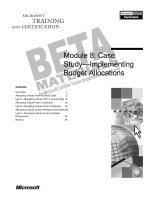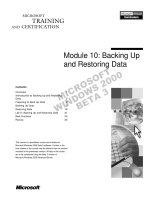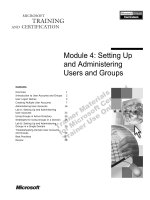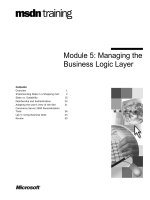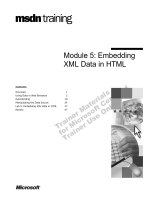Tài liệu Module 14 (Optional): Threading and Asynchronous Programming pptx
Bạn đang xem bản rút gọn của tài liệu. Xem và tải ngay bản đầy đủ của tài liệu tại đây (1.13 MB, 118 trang )
Contents
Overview 1
Introduction to Threading 2
Using Threads in .NET 9
Thread Safety 29
Special Thread Topics 51
Asynchronous Programming in .NET 74
Lab 14: Working With Multithreaded
Applications 92
Review 108
Module 14 (Optional):
Threading and
Asynchronous
Programming
Information in this document, including URL and other Internet Web site references, is subject to
change without notice. Unless otherwise noted, the example companies, organizations, products,
domain names, e-mail addresses, logos, people, places, and events depicted herein are fictitious,
and no association with any real company, organization, product, domain name, e-mail address,
logo, person, places or events is intended or should be inferred. Complying with all applicable
copyright laws is the responsibility of the user. Without limiting the rights under copyright, no
part of this document may be reproduced, stored in or introduced into a retrieval system, or
transmitted in any form or by any means (electronic, mechanical, photocopying, recording, or
otherwise), or for any purpose, without the express written permission of Microsoft Corporation.
Microsoft may have patents, patent applications, trademarks, copyrights, or other intellectual
property rights covering subject matter in this document. Except as expressly provided in any
written license agreement from Microsoft, the furnishing of this document does not give you any
license to these patents, trademarks, copyrights, or other intellectual property.
2001-2002 Microsoft Corporation. All rights reserved.
Microsoft, ActiveX, BizTalk, IntelliMirror, Jscript, MSDN, MS-DOS, MSN, PowerPoint,
Visual Basic, Visual C++, Visual C#, Visual Studio, Win32, Windows, Windows Media, and
Window NT are either registered trademarks or trademarks of Microsoft Corporation in the U.S.A.
and/or other countries.
The names of actual companies and products mentioned herein may be the trademarks of their
respective owners.
Module 14 (Optional): Threading and Asynchronous Programming iii
Instructor Notes Module 14
This module provides students with knowledge about the support that the
Microsoft
®
.NET Framework provides for working with multithreaded
applications and asynchronous programming.
After completing this module, students will be able to:
!
Create and manage threads.
!
Create thread-safe code.
!
Create and use timers.
!
Create threads using thread pools.
!
Create managed threads that interact well with COM components.
!
Create Microsoft Windows
®
Forms applications with background threads.
!
Make asynchronous calls using delegates.
Materials and Preparation
This section provides the materials and preparation tasks that you need to teach
this module.
Required Materials
To teach this module, you need the Microsoft PowerPoint® file 2349B_14.ppt.
Preparation Tasks
To prepare for this module:
!
Read all of the materials for this module.
!
Practice the demonstrations.
!
Complete the lab.
Presentation:
150 Minutes
Lab:
60 Minutes
iv Module 14 (Optional): Threading and Asynchronous Programming
Demonstrations
This section provides demonstration procedures that will not fit in the margin
notes or are not appropriate for the student notes.
The code for each of the following demonstrations is contained in project
folders that are located in <install folder>\Democode\Mod14.
Use the debugger to step through the code while you point out features and ask
students what they think will happen next.
Managing Threads
In this demonstration, you will show students how to create and manage threads
in the .NET Framework by using some of the classes and methods that were
covered in Using Threads in .NET.
The code for this demonstration is contained in one project and is located in
<install folder>\Democode\Mod14\Demo14.1.
Interrupt and Abort
In this demonstration, you will show students how to terminate threads by using
the Thread.Interrupt and Thread.Abort methods.
The code for this demonstration is contained in one project and is located in
<install folder>\Democode\Mod14\Demo14.2.
Using Synchronization Contexts and Synchronized Code
Regions to Provide Thread Safety
In this demonstration, you will use a series of tests to show students how to
achieve thread safety through the use of synchronization contexts and
synchronized code regions.
The code for this demonstration is contained in one project and is located in
<install folder>\Democode\Mod14\Demo14.3.
Using Synchronization Techniques and Thread Pooling
In this demonstration, you will show students how to perform synchronization
by using the C# lock keyword and manual synchronization primitives, and also
how to obtain multiple threads by using a thread pool.
The code for this demonstration is contained in one project and is located in
<install folder>\Democode\Mod14\Demo14.4.
Module 14 (Optional): Threading and Asynchronous Programming v
Windows Forms Threading
In this demonstration, you will show students how to use a background thread
in a Windows Forms application.
The code for this demonstration is contained in one project and is located in
<install folder>\Democode\Mod14\Demo14.5.
Asynchronous File Stream Read
In this demonstration, you will show students how to use synchronous and
asynchronous read methods on a file stream. For the asynchronous case, you
will show four different ways to complete the operation: callback, poll, end
method call, and wait with timeout.
The code for this demonstration is contained in one project and is located in
<install folder>\Democode\Mod14\Demo14.6.
Using a Delegate
In this demonstration, you will show students how to use a delegate object to
make asynchronous calls.
The code for this demonstration is contained in one project and is located in
<install folder>\Democode\Mod14\Demo14.7.
Multimedia Presentation
This section lists the multimedia items that are part of this module. Instructions
for launching and playing the multimedia are included with the relevant slides.
Asynchronous Programming
This animation illustrates the .NET Framework common language runtime
support for asynchronous programming using Delegate objects.
vi Module 14 (Optional): Threading and Asynchronous Programming
Module Strategy
Use the following strategy to present this module:
!
Introduction to Threading
Provide a general introduction to the concept of threads and discuss
advantages and disadvantages of using them. As a simple illustration of the
concept of threading, use Microsoft Internet Explorer to show how you can
still do work while waiting for a download operation to complete.
Provide a high level overview of the System.Threading namespace and
introduce the asynchronous design pattern, which you will cover in more
detail in Asynchronous Programming in .NET.
Explain how application domains play a key role in .NET threading
architecture.
!
Using Threads in .NET
Focus on the classes in the System.Threading namespace that are used to
start, manage, and terminate threads.
In addition to the preceding operations, discuss the role of managed thread
local storage.
!
Thread Safety
Focus on the issues that students may encounter in multithreaded
programming from sharing data and resources between threads, as a result
of thread synchronization.
Introduce strategies that the .NET Framework provides for dealing with
synchronization, in particular classes and interfaces in System.Threading.
!
Special Thread Topics
Introduce the Thread.Timer class, which provides a mechanism for
executing methods at specified intervals. Explain how a TimerCallback
delegate is used in conjunction with a Timer.
Discuss the use of thread pools in making multiple threads operate more
efficiently.
Discuss how managed threads call into a COM object.
Outline best practices for implementing thread-safe code.
Module 14 (Optional): Threading and Asynchronous Programming vii
!
Asynchronous Programming in .NET
Provide a brief definition of the concept of asynchronous programming as
the ability to issue method calls to other components, and to carry on with
other work without waiting for the operation to complete.
Introduce the asynchronous design pattern, and emphasize that one of its
innovations is that the caller can decide whether a particular call should be
asynchronous.
Spend most of the time in this section on the Asynchronous File Stream
Read Example. In addition to the code on the slides and information in the
Student Notes, there is an accompanying demonstration.
Discuss the use of Asynchronous delegates to call a synchronous method in
an asynchronous manner.
Play the Asynchronous Programming animation to illustrate the .NET
Framework common language runtime support for asynchronous
programming using Delegate objects.
Module 14 (Optional): Threading and Asynchronous Programming 1
Overview
!
Introduction to Threading
!
Using Threads in .NET
!
Thread Safety
!
Special Thread Topics
!
Asynchronous Programming in .NET
*****************************
ILLEGAL FOR NON
-
TRAINER USE
******************************
In this module, you will learn about the support that the Microsoft
®
.NET
Framework provides for working with multithreaded applications and
asynchronous programming. The common language runtime abstracts much of
the threading support into classes that greatly simplify most threading tasks.
Even if you do not create your own threads explicitly, you need to understand
how your code should handle multiple threads if it is run in a multithreaded
environment.
You will also learn how to handle thread synchronization to maintain
application responsiveness and avoid potential data corruption and other
problems.
In the .NET Framework, asynchronous programming is a feature that is
supported by Remoting, Networking: HTTP, TCP, File I/O, ASP.NET, and
Microsoft Message Queue Server (MSMQ). Because asynchronous
programming is a core concept, the .NET Framework provides a common
design pattern for handling asynchronous execution. This module introduces the
.NET Framework asynchronous Design Pattern and gives examples of its use.
After completing this module, you will be able to:
!
Create and manage threads.
!
Create thread-safe code.
!
Create and use timers.
!
Create threads using thread pools.
!
Create managed threads that interact well with COM components.
!
Create Microsoft Windows
®
Forms applications with background threads.
!
Make asynchronous calls using delegates.
Topic Objective
To provide an overview of
the module topics and
objectives.
Lead-in
In this module, you will learn
about the support that the
.NET Framework provides
for working with
multithreaded applications
and asynchronous
programming.
2 Module 14 (Optional): Threading and Asynchronous Programming
"
""
"
Introduction to Threading
!
Overview of Threads
!
Overview of Support for Threading in .NET
!
Thread Architecture in .NET
*****************************
ILLEGAL FOR NON
-
TRAINER USE
******************************
In this section, you will learn about the advantages and disadvantages of using
threads and the support for threads that is provided by the .NET Framework.
Topic Objective
To provide an overview of
the topics that you will cover
in this section.
Lead-in
In this section, you will learn
about the advantages and
disadvantages of using
threads and the support for
threads that is provided by
the .NET Framework.
Module 14 (Optional): Threading and Asynchronous Programming 3
Overview of Threads
!
Threads
#
The basic unit to which an operating system allocates processor time
#
Enable multiple activities to appear to occur simultaneously
!
Advantages of using multiple threads
#
Application does background processing while keeping the UI responsive
#
Distinguish tasks of varying priority
#
Communicate over a network, to a Web server, and to a database
!
Potential disadvantages of using threads
#
Diminished performance due to increased operating system overhead, for
example, thread context switching
#
Controlling code execution with many threads is complex, and can be a
source of many difficult to find and fix bugs
*****************************
ILLEGAL FOR NON
-
TRAINER USE
******************************
Whether you are developing for computers with one processor or several, you
want your application to provide the most responsive interaction with the user,
even if the application is currently doing other work. Using multiple threads of
execution is one of the most powerful ways to keep your application responsive
to the user and at the same time make use of the processor in between or even
during user events.
Threads
Threads are the basic unit to which an operating system allocates processor
time, and more than one thread can execute code inside a process. Each thread
maintains exception handlers, a scheduling priority, and a set of structures that
the system uses to save the thread context until it is scheduled. The thread
context includes all of the information that the thread needs to smoothly resume
execution, including the thread’s set of CPU registers and stack, in the address
space of the thread’s host process.
Operating systems use processes to separate the different applications that they
are executing. The .NET Framework further subdivides an operating system
process into lightweight, managed subprocesses, called application domains,
represented by System.AppDomain. One or more managed threads,
represented by System.Threading.Thread, can run in one or any number of
application domains within the same process. A preemptive multitasking
operating system allocates a processor time slice to each thread that it executes.
Because each time slice is small, multiple threads appear to execute at the same
time.
Topic Objective
To define threads in the
context of general
multitasking and state the
primary advantages and
disadvantages of using
threads.
Lead-in
Whether you are developing
for computers with one
processor or several, you
want your application to
provide the most responsive
interaction with the user,
even if the application is
currently doing other work.
Delivery Tip
You can quickly illustrate
how multiple threads are
used to create nonblocking
UI by running the Microsoft
Internet Explorer Web
browser. Start the browser
and type a URL address or
click a link to a site that
takes some time to
download. Show how you
can still interact with the
application during this
download operation, for
example, canceling the
current download by clicking
Stop.
4 Module 14 (Optional): Threading and Asynchronous Programming
Advantages of using multiple threads
Threads enable multiple activities to appear to occur simultaneously in an
application. For example, a user can edit a worksheet while another thread
recalculates other parts of the worksheet within the same application. Threading
maintains the responsiveness of the user interface while background processing
is occurring. Threads can be used to enable users to receive notification of a
task’s progress, and even to cancel the task at any time.
You can also use threads to distinguish tasks of varying priority. For example,
you can use a high-priority thread to manage time-critical tasks, and a low-
priority thread to perform other tasks.
Threads are also useful when an application must wait for an event, such as user
input or a read from the network or from a file, before continuing to execute.
Multiple threads enable the processor to handle a separate task while waiting
for the completion of the event.
Potential disadvantages of using threads
In some circumstances, threading may cause application performance to
degrade. On a single-processor computer, a compute-bound task, such as
calculating a series of values by using multiple threads, would be slower
because of the overhead caused by thread-switching. Keeping track of a large
number of threads consumes significant processor time. If there are too many
threads, most of them will not make significant progress.
Controlling code execution with many threads is complex, and can be a source
of many bugs. You run the risk of data corruption or other problems, such as
deadlocks and race conditions. To protect an application’s data from possible
corruption, you must ensure that access to shared data is properly synchronized.
For more information about deadlocks and race conditions, see Thread Safety in
this module.
While this module focuses on threading, there are other ways of
achieving concurrency that include using multiple processes/AppDomains,
messaging, and database stored procedures.
Note
Module 14 (Optional): Threading and Asynchronous Programming 5
Overview of Support for Threading in .NET
!
Basic thread namespace
#
System.Threading
!
Standard design pattern for asynchronous
programming
#
Hides thread creation and synchronization details
#
Supported by .NET Framework delegate classes and/or
the IAsyncResult interface
*****************************
ILLEGAL FOR NON
-
TRAINER USE
******************************
To provide support for multithreaded programming, the .NET Framework
supplies its own namespace for thread creation and management and a
programming model to handle asynchronous operations.
Basic thread namespace
The System.Threading namespace provides classes and interfaces that enable
multithreaded programming. System.Threading includes classes that are used
to create and manage threads, protect shared data, and improve system
responsiveness.
The System.Threading.Thread class is an abstraction of a managed thread that
executes within the runtime. This includes threads that are created by the
runtime and those that are created outside the runtime but that interact with the
runtime environment to execute some managed code.
The System.Threading namespace includes classes that assist with thread
synchronization and protection of shared data. For example, the
System.Threading.Interlocked class provides atomic operations for variables
that are shared by multiple threads. The System.Threading.Monitor class
provides a synchronization mechanism to ensure that where multiple threads
access a shared resource, only one thread can access the resource at a particular
time.
Topic Objective
To provide a high-level
overview of the
System.Threading
namespace and introduce
the asynchronous design
pattern.
Lead-in
Before examining how
threads work in the .NET
Framework, let’s briefly
review important ways in
which the .NET Framework
provides support for
threading.
6 Module 14 (Optional): Threading and Asynchronous Programming
Standard design pattern for asynchronous programming
The standard asynchronous design pattern in the .NET Framework provides an
efficient model to manage asynchronous operations and provide a consistent
programming model. The .NET Framework provides support for asynchronous
programming using the IAsyncResult interface and delegate classes that enable
a programmer to avoid some of the implementation details of threading. The
asynchronous design pattern is covered in more detail later in this module.
For more information about the System.Threading namespace and its classes,
see System.Threading Namespace in the .NET Framework SDK
documentation.
Module 14 (Optional): Threading and Asynchronous Programming 7
Thread Architecture in .NET
Example of a Process Hosting AppDomains
AppDomain A AppDomain B
Shared Data
Shared Data
Shared Data
Shared Data
Thread 1 Thread 2 Thread 3
Thread
Specific
Data
Thread
Specific
Data
Thread
Specific
Data
Thread
Specific
Data
Thread
Specific
Data
Thread
Specific
Data
*****************************
ILLEGAL FOR NON
-
TRAINER USE
******************************
Application domains, also known as AppDomains, play a key role in how
threads work in the .NET Framework. An application domain is a runtime
representation of a logical process within a physical process. A single process
can contain multiple application domains, each of which is completely isolated
from other application domains within this or any other process. One or more
threads run in an application domain.
Although hosting threads within application domains is conceptually similar to
the COM threading model with its use of apartments, there is an important
difference: application domains are managed types whereas the COM threading
model is built on an unmanaged architecture.
For more information about application domains, see Module 2, “Introduction
to a Managed Execution Environment,” in Course 2349B, Programming with
the Microsoft .NET Framework (Microsoft Visual C# .NET).
Topic Objective
To explain thread
architecture in .NET in terms
of application domains.
Lead-in
Let’s look at the different
architectural components
that make up a single .NET
process.
8 Module 14 (Optional): Threading and Asynchronous Programming
Mapping from Win32 Threading to Managed Threading
The following table maps Microsoft Win32
®
threading elements to their
approximate runtime equivalent. Note that this mapping does not represent
identical functionality. For example, TerminateThread does not execute
finally clauses or free up resources, and cannot be prevented. However,
Thread.Abort executes all of your rollback code, reclaims all of the resources,
and can be denied by using ResetAbort. Be sure to read the .NET Framework
SDK closely before making assumptions about functionality.
In Win32 In the common language runtime
CreateThread Combination of new Thread() and
Thread.Start
TerminateThread Thread.Abort
SuspendThread Thread.Suspend
ResumeThread Thread.Resume
Sleep Thread.Sleep
WaitForSingleObject on the thread handle Thread.Join
ExitThread No equivalent
GetCurrentThread Thread.CurrentThread
SetThreadPriority Thread.Priority
No equivalent Thread.Name
No equivalent Thread.IsBackground
Close to CoInitializeEx (Ole32.dll) Thread.ApartmentState
Module 14 (Optional): Threading and Asynchronous Programming 9
"
""
"
Using Threads in .NET
!
Starting Threads
!
Thread Properties and Parameters
!
Managing Threads
!
Thread Local Storage
!
Interrupting and Terminating Threads
*****************************
ILLEGAL FOR NON
-
TRAINER USE
******************************
In this section you will learn how to start, manage, and terminate threads.
The System.Threading namespace includes classes for starting managing, and
terminating threads.
Being able to perform basic threading operations is only the first requirement in
creating multithreaded applications. On a more advanced level, you must
consider issues of data protection and performance. These issues are covered in
the topic Thread Safety in this module.
Topic Objective
To provide an overview of
the topics that you will cover
in this section.
Lead-in
Having briefly reviewed how
an operating system uses
threads to perform
multitasking, let’s look at
how threading works in the
.NET Framework.
10 Module 14 (Optional): Threading and Asynchronous Programming
Starting Threads
!
Create a new instance of a Thread Object
#
Constructor takes a ThreadStart delegate as its only
parameter
#
ThreadStart references the method that will be
executed by the new thread
!
Thread is not executed until the Thread.Start method is
invoked
Thread t = new
Thread(new ThreadStart(MyClass.AStaticMethod));
t.Start();
Thread t = new
Thread(new ThreadStart(MyClass.AStaticMethod));
t.Start();
*****************************
ILLEGAL FOR NON
-
TRAINER USE
******************************
Creating a new instance of a Thread class creates a new managed thread. The
constructor for Thread takes, as its only parameter, a ThreadStart delegate
that references the method that will be executed by the new thread. The Thread
function does not begin executing until the Start method is called.
Topic Objective
To explain how to instantiate
and start a new thread by
using the .NET Framework
classes.
Lead-in
Creating a new instance of a
Thread
class creates a new
managed thread.
Module 14 (Optional): Threading and Asynchronous Programming 11
The following code shows how to create and start new threads:
using System;
using System.Threading;
class MyClass
{
//…
public static void AStaticMethod()
{
//…
}
public void AnInstanceMethod()
{
//…
}
}
class App
{
static void Main()
{
// Create and start thread on an instance method
MyClass aMyClass = new MyClass();
Thread t1 = new
Thread(new ThreadStart(aMyClass.AnInstanceMethod));
t1.Start();
// Create and start thread on a static method
Thread t2 = new
Thread(new ThreadStart(MyClass.AStaticMethod));
t2.Start();
//…
}
}
In the preceding example, the calls to t1.Start and t2.Start place the t1 and t2
threads in the running state, and the operating system can schedule them for
execution. The Start method submits an asynchronous request to the system,
and the call returns immediately, possibly before the new thread has started.
The thread’s execution begins at the first line of the method that is referred to
by the thread delegate. Calling Start more than once on the same thread causes
the runtime to throw a ThreadStateException.
12 Module 14 (Optional): Threading and Asynchronous Programming
Thread Properties and Parameters
!
Use the Thread.Name and Thread.Priority properties to
get or set the name and priority of the thread
!
Designate a thread as a background or a foreground
thread by setting the Thread.IsBackground property
#
A background thread will not keep the managed
execution environment alive
!
Encapsulate thread parameters in an object
t.Name = "My Background Thread";
t.Priority = ThreadPriority.AboveNormal;
t.IsBackground = true;
t.Name = "My Background Thread";
t.Priority = ThreadPriority.AboveNormal;
t.IsBackground = true;
*****************************
ILLEGAL FOR NON
-
TRAINER USE
******************************
To get or set the name of a thread and its priority, use the Thread.Name and
Thread.Priority properties. Thread.Priority gets or sets the following values
that indicate the scheduling priority of a thread:
!
Highest
!
AboveNormal
!
Normal
!
BelowNormal
!
Lowest
For example, to set the name of a thread t to “My Background Thread” and
make its priority AboveNormal, you use the following code:
t.Name = "My Background Thread";
t.Priority = ThreadPriority.AboveNormal;
Because the details of scheduling algorithms vary with each operating
system, operating systems are not required to honor the priority of a thread.
Topic Objective
To describe some key
Thread
class properties and
how to pass parameters to
threads.
Lead-in
To get or set the name of a
thread and its priority, use
the
Thread.Name
and
Thread.Priority
properties.
Note
Module 14 (Optional): Threading and Asynchronous Programming 13
Background and Foreground Threads
A managed thread runs as a background thread or a foreground thread.
Background threads are identical to foreground threads except that a
background thread does not keep the managed execution environment alive.
After all foreground threads have been stopped in a managed process (where
the .exe file is a managed assembly), the system stops all background threads
and shuts down. You can designate a thread as a background or foreground
thread by setting the Thread.IsBackground property.
For example, to designate a thread as a background thread, you set
Thread.IsBackground to true. Likewise, to designate a thread as foreground
thread, set IsBackground to false.
All threads that enter the managed execution environment from unmanaged
code are marked as background threads. All threads that are generated by
creating and starting a new Thread object are foreground threads. If you create
a thread that you want to listen for some activity, such as a socket connection,
you should set Thread.IsBackground to true, so that your process can
terminate.
For example, to set a thread t to be a background thread:
t.IsBackground = true;
14 Module 14 (Optional): Threading and Asynchronous Programming
Encapsulating thread parameters in an object
It is sometimes important to supply parameters to a thread. However, the
ThreadStart delegate takes as its only parameter a ThreadStart delegate. The
following code demonstrates how to use an object to encapsulate thread
parameters:
using System;
using System.Threading;
class MyClassWithThreadState
{
int sleepTime;
public MyClassWithThreadState(int sleepTime)
{
this.sleepTime = sleepTime;
}
public void ThreadMethod()
{
// method can reference sleepTime
Thread.Sleep(sleepTime);
}
}
class Class1
{
static void Main()
{
int sleepTime = 1000; // time for the thread to sleep
MyClassWithThreadState myClassWithThreadState =
new MyClassWithThreadState(sleepTime);
Thread ts = new Thread(new
ThreadStart(myClassWithThreadState.ThreadMethod));
ts.Start();
// …
}
}
Module 14 (Optional): Threading and Asynchronous Programming 15
Managing Threads
!
Thread.Sleep causes the current thread to block
!
Suspend and Resume methods are not generally useful
#
Can result in serious application problems like deadlocks
!
Thread.Join waits for another thread to stop
!
Thread.WaitHandle methods wait for one or more events
!
Thread.ThreadState property - bit mask of the thread's state
Thread.Sleep(3000); // blocks for 3 seconds
Thread.Sleep(3000); // blocks for 3 seconds
t.Start();
t.Join(); // Wait for the thread to exit
t.Start();
t.Join(); // Wait for the thread to exit
WaitHandle.WaitAll(waitEvents);
WaitHandle.WaitAll(waitEvents);
*****************************
ILLEGAL FOR NON
-
TRAINER USE
******************************
Typically, thread management includes tasks such as suspending a thread for a
period of time, waiting until another thread completes, or waiting until one or
more specific events occur.
Pausing and Resuming Threads
After starting a thread, you sometimes need to pause that thread for a fixed
period of time. Calling Thread.Sleep causes the current thread to immediately
block for the number of milliseconds you pass to Sleep, yielding the remainder
of its time slice to another thread. One thread cannot call Sleep on another
thread. For example, to cause the current thread to suspend for three seconds,
call the static method of Thread.Sleep as follows:
Thread.Sleep(3000);
Calling Thread.Sleep(Timeout.Infinite) causes a thread to sleep until it is
interrupted by another thread that calls Thread.Interrupt or is aborted by
Thread.Abort.
Using Thread.Suspend to pause a thread
You can also pause a thread by calling Thread.Suspend. When a thread calls
Thread.Suspend on itself, the call blocks until the thread is resumed by
another thread.
When one thread calls Thread.Suspend on another thread, the call is a
nonblocking call that causes the other thread to pause. Calling Thread.Resume
breaks another thread out of the suspended state and causes the thread to resume
execution, regardless of how many times Thread.Suspend was called. For
example, if you call Thread.Suspend five consecutive times and then call
Thread.Resume, the thread resumes execution immediately following the call
to Resume.
Topic Objective
To describe the classes that
the runtime uses to pause,
resume, and force threads
to wait.
Lead-in
Let’s look at how the
runtime provides classes to
manage threads.
16 Module 14 (Optional): Threading and Asynchronous Programming
Unlike Thread.Sleep, Thread.Suspend does not cause a thread to immediately
stop execution. The runtime must wait until the thread has reached a safe point
before it can suspend the thread. A thread cannot be suspended if it has not been
started or if it has stopped.
For more information about safe points, see the .NET Framework SDK.
The Suspend and Resume methods are not generally useful for applications,
and you should not confuse them with synchronization mechanisms. Because
Suspend and Resume do not rely on the cooperation of the thread that is being
controlled, they are highly intrusive and can cause serious application problems.
For example, if you suspend a thread that holds a resource needed by another
thread, this causes a deadlock condition.
Some applications do need to control the priority of threads for better
performance. To do this, you should use Thread.Priority rather than
Thread.Suspend in your application.
Using Thread.Join to pause a thread
You can force a thread to wait for another thread to stop by calling
Thread.Join, as shown in the following code:
using System;
using System.Threading;
class MyApp
{//…
static void MyThreadMethod()
{
//…
}
static void Main()
{
// create, start and join a simple background thread
// MyThreadMethod is the secondary thread's entry point.
Thread t = new Thread(new ThreadStart(MyThreadMethod));
// Start the thread
t.Start();
// Wait for the thread to exit
t.Join();
}
}
Module 14 (Optional): Threading and Asynchronous Programming 17
Using the WaitHandle class to wait for events
You can force a thread to wait for one or more events to occur by calling
methods in the Thread.WaitHandle class.
The following table describes some of the methods in the WaitHandle class.
Method Description
WaitAll This method waits for all of the elements in the specified array to
receive a signal.
WaitAny This method waits for any of the elements in the specified array to
receive a signal.
WaitOne This method blocks the current thread until the current WaitHandle
receives a signal.
The WaitHandle class encapsulates Win32 synchronization handles. While
WaitHandle objects represent operating system synchronization objects and
expose advanced functionality, they are less portable than the Monitor.Wait
method, which is fully managed and, in some circumstances, is more efficient
in its use of operating system resources.
Using Classes that are derived from WaitHandle
Examples of classes that derive from WaitHandle include AutoResetEvent,
ManualResetEvent, and Mutex.
You use the AutoResetEvent class to make a
thread wait until some event puts it in the signaled state by calling
AutoResetEvent.Set. Unlike ManualResetEvent, AutoResetEvent is
automatically reset to nonsignaled by the system after a single waiting thread
has been released. If no threads are waiting, the event object’s state remains
signaled. The AutoResetEvent corresponds to a Win32 CreateEvent call,
false specified by the bManualReset argument.
